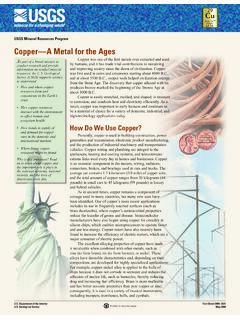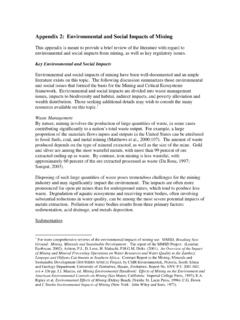Transcription of Eutrophication: Causes, Consequences, and Controls in ...
1 4/23/131/8By: Michael F. Chislock (Department of Fisheries and Allied Aquacultures, Auburn University), EnriqueDoster (Department of Animal Sciences, Auburn University), Rachel A. Zitomer (Department of BiologicalSciences, Humboldt University) & Alan E. Wilson (Department of Fisheries and Allied Aquacultures,Auburn University) 2013 Nature Education eutrophication : causes , consequences , and Controls inAquatic EcosystemsEutrophication is a leading cause of impairment of many freshwater and coastal marineecosystems in the world. Why should we worry about eutrophication and how is thisproblem managed?
2 IntroductionEutrophication is characterized by excessive plant and algal growth due to the increased availability of oneor more limiting growth factors needed for photosynthesis (Schindler 2006), such as sunlight, carbondioxide, and nutrient fertilizers. eutrophication occurs naturally over centuries as lakes age and are filled inwith sediments (Carpenter 1981). However, human activities have accelerated the rate and extent ofeutrophication through both point-source discharges and non-point loadings of limiting nutrients, such asnitrogen and phosphorus, into aquatic ecosystems ( , cultural eutrophication ), with dramaticconsequences for drinking water sources, fisheries, and recreational water bodies (Carpenter et al.)
3 1998).For example, aquaculture scientists and pond managers often intentionally eutrophy water bodies by addingfertilizers to enhance primary productivity and increase the density and biomass of recreationally andeconomically important fishes (Figure 1) via bottom-up effects on higher trophic levels (Boyd & Tucker 1998).However, during the 1960s and 1970s, scientists linked algal blooms to nutrient enrichment resulting fromanthropogenic activities such as agriculture, industry, and sewage disposal (Schindler 1974). The knownconsequences of cultural eutrophication include blooms of blue-green algae ( , cyanobacteria, Figure 2),tainted drinking water supplies, degradation of recreational opportunities, and hypoxia.
4 The estimated cost ofdamage mediated by eutrophication in the alone is approximately $ billion annually (Dodds et ).Citation: Chislock, M. F., Doster, E., Zitomer, R. A. & Wilson, A. E. (2013) Eutrophication: causes , consequences , and Controls in aquatic ecosystems . Nature EducationKnowledge 4(4):10 1 Aquaculture ponds, such as these channel catfish production ponds, typically contain high concentrations of nutrients, such asnitrogen and phosphorus, due to regular feeding of the fish. Consequently, these ponds are also plagued by recurringcyanobacterial blooms and hypoxia.
5 2013 Nature Education Photos by Mark Peterman and Michael Chislock. All rights reserved. Figure 2 Sampling Lago de P tzcuaro during a cyanobacterial bloom w ithIlyana Berry, Dr. John Berry, and Dr. Fernando Bernal-Brooks. 2013 Nature Education Photo by Alan Wilson. Allrights reserved. most conspicuous effect of cultural eutrophication is the creation of dense blooms of noxious, foul-smelling phytoplankton that reduce water clarity and harm water quality (Figure 2). Algal blooms limit lightpenetration, reducing growth and causing die-offs of plants in littoral zones while also lowering the successof predators that need light to pursue and catch prey (Lehtiniemi et al.)
6 2005). Furthermore, high rates ofphotosynthesis associated with eutrophication can deplete dissolved inorganic carbon and raise pH toextreme levels during the day. Elevated pH can in turn blind' organisms that rely on perception of dissolvedchemical cues for their survival by impairing their chemosensory abilities (Figure 3) (Turner & Chislock2010). When these dense algal blooms eventually die, microbial decomposition severely depletes dissolvedoxygen, creating a hypoxic or anoxic dead zone' lacking sufficient oxygen to support most organisms. Deadzones are found in many freshwater lakes including the Laurentian Great Lakes ( , central basin of LakeErie; Arend et al.
7 2011) during the summer. Furthermore, such hypoxic events are particularly common inmarine coastal environments surrounding large, nutrient-rich rivers ( , Mississippi River and the Gulf ofMexico; Susquehanna River and the Chesapeake Bay) and have been shown to affect more than 245,000square kilometers in over 400 near-shore systems (Diaz & Rosenberg 2008). Hypoxia and anoxia as a resultof eutrophication continue to threaten lucrative commercial and recreational fisheries 3 Helisoma trivolvis (left) and Physa acuta (right) are tw o of the most common freshw ater snails in North America.
8 Bothspecies use chemical cues to detect predators such as molluscivorous fish and typically respond by hiding under rocks andlogs or in shallow w ater. 2013 Nature Education Photo by Andy Turner. All rights reserved. Some algal blooms pose an additional threat because they produce noxious toxins ( , microcystin andanatoxin-a; Chorus and Bartram 1999). Over the past century, harmful algal blooms (HABs) have beenlinked with (1) degradation of water quality (Francis 1878), (2) destruction of economically important fisheries(Burkholder et al. 1992), and (3) public health risks (Morris 1999).
9 Within freshwater ecosystems ,cyanobacteria are the most important phytoplankton associated with HABs (Paerl 1988). , including Anabaena, Cylindrospermopsis, Microcystis, and Oscillatoria (Planktothrix), tend todominate nutrient-rich, freshwater systems due to their superior competitive abilities under high nutrientconcentrations, low nitrogen-to-phosphorus ratios, low light levels, reduced mixing, and high temperatures(Downing et al. 2001; Paerl & Huisman 2009; Paerl and Paul 2012). Poisonings of domestic animals, wildlife(Figure 4), and even humans by blooms of toxic cyanobacteria have been documented throughout the worldand date back to Francis' (1878) first observation of dead livestock associated with a bloom of , cyanobacteria are responsible for several off-flavor compounds ( , methylisoborneal andgeosmin) found in municipal drinking water systems as well as in aquaculture-rased fishes, resulting in largefinancial losses for state and regional economies (Crews & Chappell 2007).
10 In addition to posing significantpublic health risks, cyanobacteria have been shown to be poor quality food for most zooplankton grazers inlaboratory studies (Wilson et al. 2006; Tillmanns et al. 2008), thus reducing the efficiency of energy transferin aquatic food webs and potentially preventing zooplankton from controlling algal 4A dead African buffalo (Syncerus caffer) found in a reservoir w ith a dense bloom of the toxic cyanobacterium Microcystis atthe Loskop Dam Nature Reserve in South Africa. 2013 Nature Education Photo by Jannie Coetzee. All rights reserved.




